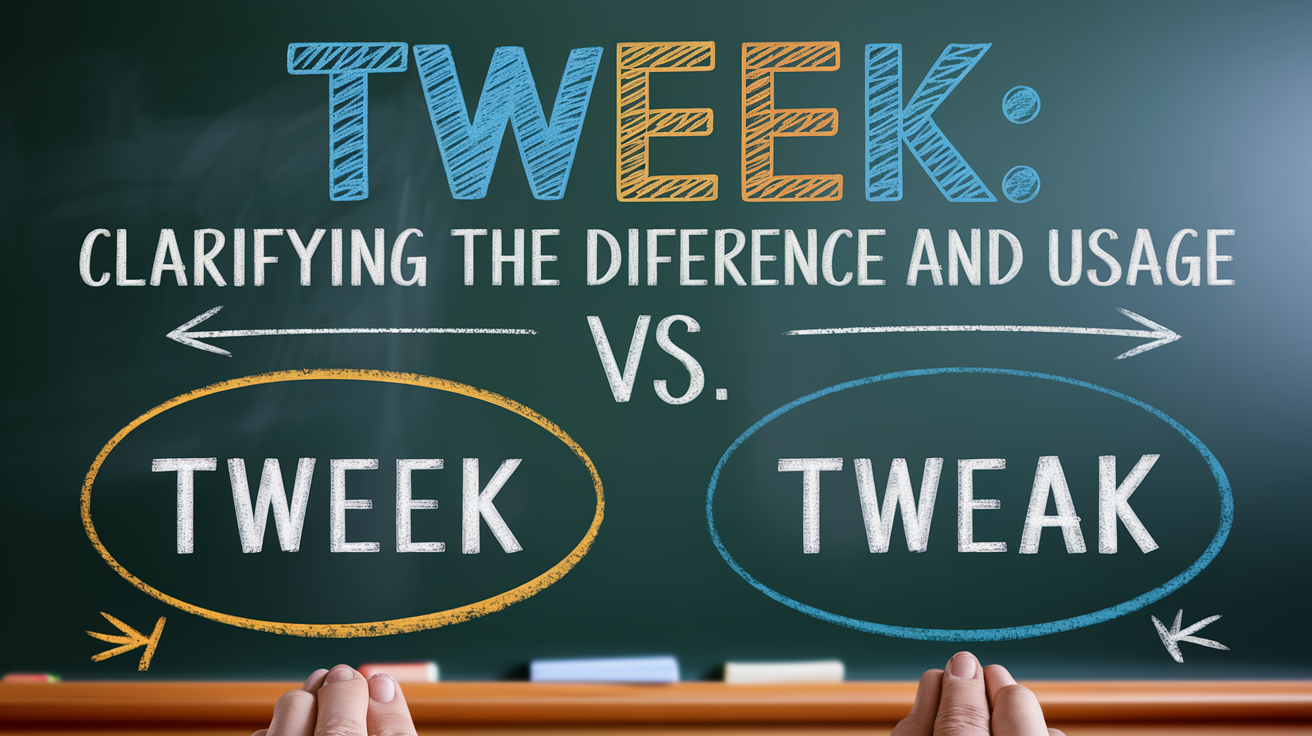Introduction
Language can be tricky, and even small errors in word choice can affect communication. One common confusion arises between “tweek” and “tweak.” While they may look similar, only one is correct.
By the end of this article, you’ll know exactly how to use “tweak” correctly and avoid the common mistake of “tweek.”
Understanding the Definitions
What Does “Tweak” Mean?
“Tweak” is a verb that means to make small adjustments or fine-tune something. It is commonly used when referring to slight modifications intended to improve functionality.
Read More About This Article: Miner or Minor: What’s the Difference?
Examples of “Tweak” in Action:
- Adjusting the settings on your phone to extend battery life.
- Making minor edits to a document for better clarity.
- Fine-tuning a recipe to better suit your taste.
Origin: The term “tweak” dates back to the 17th century, originally referring to pinching or pulling something. Over time, it evolved to mean making small adjustments.
What Does “Tweek” Mean?
“Tweek” is simply a misspelling of “tweak.” It has no recognized definition in standard English and is considered an error.
Common Misuses:
- “I need to tweek the website design.” ❌
- “He tweeked the report before submitting it.” ❌
Correction: The correct word is “tweak.”
Proper Usage of “Tweak”
Everyday Uses:
- Cooking: “She tweaked the recipe by adding extra spices.”
- Technology: “I need to tweak the app’s settings to improve performance.“
- Design: “The artist tweaked the layout for a more balanced look.”
Professional Applications:
- Technical Writing: Adjusting a process description for clarity.
- Business Presentations: Refining slides to enhance communication.
- Academic Research: Making slight modifications to methodologies for precision.
Common Synonyms for “Tweak”
To avoid repetition, consider using these words:
- Adjust
- Modify
- Fine-tune
- Revise
- Alter
Why Misspelling Matters
Using “tweek” instead of “tweak” might seem like a small mistake, but it can have significant consequences.
Reduced Credibility
Misspellings can make your writing appear careless, especially in professional settings:
- A job applicant’s cover letter with “tweek” instead of “tweak” may leave a negative impression.
- In academic papers, precise language enhances credibility.
Potential Misunderstandings
Errors like “tweek” can confuse readers and disrupt communication. Using the correct word ensures clarity.
How to Avoid Misspelling “Tweak”
Here are some easy ways to prevent this common mistake:
- Mnemonic Device: “Tweak starts with ‘tw,’ just like ‘twist.’” This can help you recall the correct spelling.
- Proofread Thoroughly: Always review your work for errors before finalizing it.
- Use Grammar Tools: Utilize spell checkers or grammar assistants to catch typos.
- Practice: Familiarize yourself with “tweak” by using it in sentences frequently.
“Tweak” in Digital and Technical Contexts
The word “tweak” is commonly used in the tech industry:
| Context | Example of Tweak Usage |
|---|---|
| Software Development | Adjusting code to fix bugs or improve functionality. |
| Gaming | Modifying game settings for better performance. |
| User Experience | Tweaking a website layout for easier navigation. |
| Hardware | Adjusting components for optimal performance. |
Cultural and Colloquial Usage of “Tweak”
Beyond formal and technical contexts, “tweak” is widely used in everyday language and pop culture:
- Slang: “Tweaking” can informally describe someone who is overly focused or obsessed.
- Pop Culture References: The word appears in movies, music, and books, often symbolizing creativity or problem-solving.
Example:
“Just tweak it a bit, and it’ll be perfect!” conveys the idea of refining something for better results.
Why Accuracy Matters
Using the right term isn’t just about correctness—it’s about effective communication.
Key Benefits of Proper Usage:
- Clarity: Prevents misunderstandings.
- Credibility: Enhances professionalism.
- Efficiency: Reduces the need for clarification.
Case Study: A Business Email Blunder
A marketing professional sent an email to a client stating, “We’ll tweek the campaign strategy.” The typo raised doubts about the company’s attention to detail, and the client chose to work with a competitor instead.
Summary and Final Thoughts
- “Tweak” means making small adjustments for improvement.
- “Tweek” is always incorrect.
- Using the correct word enhances clarity and professionalism.
Final Takeaway:
Strive for accuracy in your writing and use tools that help improve communication. Whether you’re tweaking a process, a piece of writing, or a design, small adjustments can make a big difference.
FAQs on “Tweek” vs. “Tweak”
What does “tweek” mean?
“Tweek” is not a recognized word in English. It is a common misspelling of “tweak.”
Is “tweek” ever correct?
No, “tweek” is always incorrect. The correct word is “tweak.”
Can “tweak” and “modify” be used interchangeably?
In many cases, yes. Both words refer to making changes, though “tweak” often implies smaller, more precise adjustments.
By understanding and applying the correct usage of “tweak,” you ensure clarity, precision, and professionalism in your communication!
